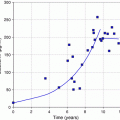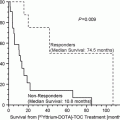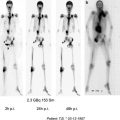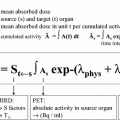© Springer-Verlag Berlin Heidelberg 2012
Richard P. Baum (ed.)Therapeutic Nuclear MedicineMedical Radiology10.1007/174_2012_740Chemotherapy Combined with Radionuclide Therapy
(1)
Department of Oncology, Fremantle hospital, Alma Street, Fremantle, WA, 6160, Australia
(2)
Department of Nuclear Medicine, School of Medicine and Pharmacology, Fremantle Hospital, The University of Western Australia, Alma Street, Fremantle, 6160, WA, Australia
Abstract
Virtually no malignancies have been cured by using single modalities of treatment. The evolution of tumour-targeted radionuclide therapies such as radioimmunotherapy and radiopeptide therapy provides a synergistic complement to conventional chemotherapy of cancer. In addition, the advent of biological agents which interfere with tumour metabolic pathways offers an exciting prospect of combination radionuclide—chemo biological therapy to enhance efficacy and minimise toxicity. The formal clinical trial evaluation of such evolving multimodality therapy of cancer is described to facilitate valid demonstration of efficacy and safety and to provide the level of evidence required for adoption into routine oncology clinical practice.
Virtually no malignancies have been cured by using single modalities of treatment.
Larry K Kvols
1 Key points
Multimodality treatment is required to control metastatic cancer. The synergistic combination of chemotherapy and radionuclides has the potential to enhance efficacy and minimise toxicity. Chemotherapeutic agents often radio-sensitise tumours to targeted radionuclide treatment and cytotoxic effects are additive. Biological molecular targeted agents may also be pro-apoptotic and increase radionuclide-induced tumour cell death. Evaluation of novel chemo-radionuclide treatment regimens by rigorous, well-designed clinical trial is imperative to provide the level of evidence required for translation to mainstream clinical oncologic practice in cancer patients. This chapter reviews recent chemo-radionuclide treatment regimens and defines the clinical trial protocol design necessary for formal assessment of toxicity and efficacy.
2 Introduction
Most radionuclide treatments are given as monotherapy whereas the conventional approach in medical oncology is a combination of chemotherapy agents, often incorporating immunotherapeutics, biological pro-apoptotic agents, radiation sensitisers and external beam radiotherapy. The growing array of radiopharmaceuticals must now prompt an exploration of synergistic combination regimens which enhance the efficacy of radionuclide treatments and minimise toxicity. Such regimens of combination radionuclide/monoclonal antibodies/chemotherapeutic radiosensitisers and biological molecular signalling modifiers must then be rigorously studied in well-designed, adequately powered clinical trials.
Systemically administered chemotherapeutic agents and radio-pharmaceuticals have distinct pharmacokinetic properties which affect their bio-availability, therapeutic activity and toxicities. Tissue radiation exposure is also affected by the relative decay times of given radionuclides, with dosage being delivered over prolonged periods. External beam therapy, on the other hand, penetrates tissues and cellular boundaries without a requirement for distribution to blood, tissue, interstitial space and cellular targets. Radiation exposure times are brief, often only a few minutes. Clinical studies of chemotherapy combined with external beam radiation are difficult to extrapolate to radionuclide therapy and will not be considered in detail in this review.
Given the manifest differences in pharmacokinetics and relative tumour size in small animal models of human cancer and the confounding effects of allometrics on extrapolation of potential therapeutic regimens to patients, the only reliable evaluation of novel radionuclide—chemotherapy combinations is in clinical trials.
This chapter examines the development of combination radionuclide—chemotherapy regimens and explores ways in which they should be evaluated in clinical trials designed to facilitate their incorporation into mainstream clinical oncology practice.
3 Clinical Evaluation Principles: The Oncologist Lexicon
Cytotoxic drugs that show anti-tumour activity and acceptable toxicities in preclinical testing will ultimately require rigorous clinical trial testing. These trials will aim to establish the range and level of drug efficacy, appropriate dosing schedules and comparability with other drug combinations or established best practice treatments. Clinical evaluation of cytotoxics generally proceeds through three phases. Phase I trials are concerned with the evaluation of toxicity in order to establish an appropriate dosage for future studies. Phase II trials evaluate the drug in specific tumour types and estimate the degree of cytotoxic activity. Phase III trials compare novel treatment strategies with standard, best practice therapy.
3.1 Phase I Trials
These early stage trials involve small patient numbers and have the principal aims of establishing the range of toxicities of a particular cytotoxic agent. An appropriate dosage range must be established to use in the next phase of testing. The clinician will always be hopeful of a therapeutic benefit, but this is far from certain and often quite uncommon in Phase I studies. Consequently patient selection is generally confined to individuals who have exhausted standard, conventional therapies but have reasonably good remaining health as characterised by:
2.
Adequate hepatic, renal, cardiac and bone marrow function.
3.
No recent anticancer therapies which might obscure evaluation of toxicities.
The typical Phase I trial involves dosage escalation (Perry 1997) such as the modified Fibonacci schema (Perry 1997), wherein cohorts of three patients are treated at each dose level until significant toxicity occurs. A maximum tolerable dose (MTD) is established once a proportion of patients at a particular dose level experience significant toxicity. A dose of 10–25 % less than MTD is generally recommended for the next phase of the testing.
3.2 Phase II Trials
Having established the MTD of a particular drug, it is then important to establish the magnitude of its anti-tumour activity in a range of malignancies. Phase II trials will ideally recruit patients with specific tumour types and again generally after these patients have progressed despite standard therapies. Sufficient patient numbers must be recruited to have the statistical power which rejects the null hypothesis that the drug has no activity. Generally this requires a confidence level of 90–95 % and statistical theory can provide an estimate of the minimum numbers of patients needed to be treated for a specified drug response rate. For example, a drug with a true response rate of 20 % would require a minimum of 14 patients before one might expect to see a single response (Wittes 1988).
The most commonly used accrual plan for Phase II studies was devised by Gehan (1961). It aims to enrol 14 patients and if no responses are seen the trial is terminated. If one or more responses are seen, then a second stage accrual is performed to more accurately estimate the response probability and confidence limits. An additional 20 patients are usually required. Modifications of this design, such as that devised by Fleming (1982) allow the investigators to set percentage response targets. The design provides a sample size large enough to ensure that a drug can be assessed as meaningfully active or inactive. Confidence intervals can then be employed to clarify what interpretations are consistent with the results (Simon 1986).
Patient selection for Phase II trials is usually quite rigorous. These patients must satisfy all the usual criteria of good performance status and metabolic functions, but they must also have measurable disease by standard imaging techniques such as CT scans. Not all malignancies have clearly measurable disease however, and then other, surrogate, markers may be necessary. For instance, in advanced prostate cancer with bone metastases measurement of the bone lesions is not possible. Here surrogate markers might be prostate specific antigen (PSA) levels, skeletal-related events, performance status and pain scores, which are quantifiable.
3.3 Phase III Trials
Treatments demonstrating significant activity in Phase II studies need to be compared to standard treatment programs. These Phase III trials will randomise patients between two or more regimens. The statistical comparison will be between the new program and older more established treatments. It is important that Phase III studies have sufficient statistical power to detect a difference between the treatment groups. Typically, the sample size needs to be quite large to detect meaningful differences of 10 % or greater between the treatment arms. Sub-stratification to allow for subgroup analyses, which consider the influences of variables such as age, sex, organ function, tumour characteristics and other factors on outcomes, dictates progressively larger patient numbers.
Good clinical practice mandates the use of Evidence-Based Medicine. Most practitioners rely on using treatments which are supported by at least level Ia, Ib or IIa data. In other words, data obtained from well-designed, controlled clinical trials, preferably randomised studies. Herein lies the difficulty for most nuclear oncologists, and clinicians working in cancer care, when evaluating the results of radionuclide studies. The vast majority of these studies provide, at best, level III evidence based upon descriptive data and case studies. Common features of most therapeutic nuclear oncology clinical studies include:
1.
The dose-finding Phase I studies have seldom been conducted rigorously to establish the MDT of the radionuclide therapy in question. Consequently the Phase II trials are not necessarily conducted at optimum dosage levels.
2.
Most nuclear oncology therapy trials are Phase II design protocols conducted in single institutions.
3.
Patient selection is not rigorously defined and biases in selection are not clearly apparent in the trial reports. Judgements about whom to include, and exclude, are not tightly regulated.
4.
Population sample sizes are inadequate and lack control over variables, such as patient characteristics and tumour differences, which result in a high probability of false positive outcomes.
5.
Rigidly controlled and verifiable response measurements, such as RECIST criteria, have not been invariably utilised.
6.
Treatment administration, including radionuclide dosage, and time intervals, can be highly variable.
7.
True Phase III comparative trials of radiopharmaceutical therapy regimens are rare.
Most combination radionuclide–chemotherapy trials have adopted an extended Phase II design; tending to adhere to fixed-dosage protocols, which unfortunately make the assumption that optimal dosage has already been established. These single arm studies, which, at best, make reference to historical control groups, fail to account for the limitations of this approach. Often the historical control group is poorly defined, of limited size, and no justification is given for its comparability to the current Phase II treatment population. If we look at sample size alone, where our historical control group of (for example 50 patients) had an observed Phase II response of 30 %, we would need to treat 70 patients with the new protocol in order to detect a 20 % improvement in response rate with a statistical power of 0.80 (Simon 1989).
3.4 Clinical Trial Design
We have seen that clinical trials require careful planning to achieve the study objective. Beyond Phase I, most studies will have multiple objectives which must be stipulated prior to trial commencement, because different objectives will only be achievable by adequate sample size, date collection and patient follow-up. Phase II studies principally aim to provide evidence of the activity of treatment in a disease-specific cohort. The ultimate aim will be to decide whether the new treatment shows sufficient promise to warrant testing against standard therapy in a large comparative trial. Phase II studies will set objectives which can be easily, and rapidly, measured as representative of the classical cytotoxic concept of cancer therapy. The most objective outcomes of cytotoxic treatment will be measures of tumour shrinkage, known as objective response rate (ORR). Tumour responses to chemotherapy are defined by the measurement system known as RECIST (response evaluation criteria in solid tumours) (Eisenhauer 2009). Target lesions will show one of several possible responses to therapy:
1.
Complete response (CR): disappearance of all target lesions.
2.
Partial response (PR): at least a 30 % decrease in the sum of diameters of target lesions.
3.
Progressive disease (PD): at least a 20 % increase in the sum of diameters of target lesions.
4.
Stable disease (SD): neither sufficient shrinkage to qualify for PR or increase to quality for PD.
Generally, response durations are measured from the start of therapy and the timing of CT/MRI/US evaluations as stipulated in the protocol. The response intervals generate a further set of important clinical trial data sets:
1.
Response duration: The duration of CR/PR is measured from the time tumour measurements first meet the CR/PR criteria until progression is seen. The duration of SD is measured from the start of therapy. These data allow calculation of time to progression (TTP) a particularly important outcome in comparative studies.
2.




Progression-free survival (PFS) is an alternative end-point in clinical trials and is measured from the start of therapy to landmark time points, such as 1 year or 2 years from initiation.
Stay updated, free articles. Join our Telegram channel

Full access? Get Clinical Tree








